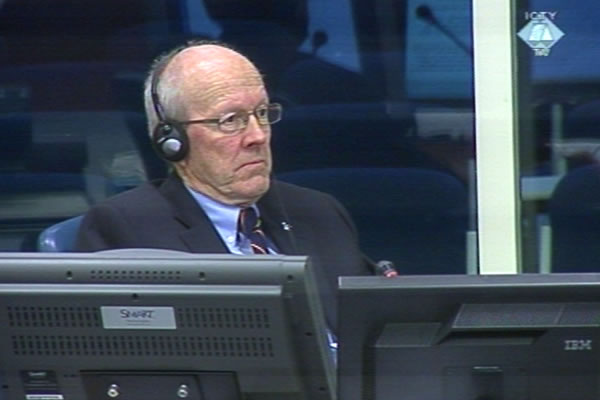Home
MLADIC ‘DOMINANT PERSONALITY’ IN THE VRS
Former head of military observers in Sarajevo Francis Roy Thomas said that the goal of the Bosnian Serb army was not to capture territory. They wanted to terrorize the civilian population with artillery and sniper attacks, Thomas insisted. According to him, the accused Ratko Mladic was the ‘dominant personality’ in the VRS
 Francis Roy Thomas, witness at the Ratko Mladic trial
Francis Roy Thomas, witness at the Ratko Mladic trial After testifying against former commanders of the Sarajevo-Romanija Corps Stanislav Galic and Dragomir Milosevic and former RS president Radovan Karadzic, the head of the UN military observers in Sarajevo Francis Roy Thomas appeared before the Tribunal for the fourth time. Thomas explained to the judges why he believed the Bosnian Serbs’ goal was to ‘terrorize the civilian population in the city’ with artillery and sniper attacks. At the trial of Ratko Mladic, Thomas described the events from October 1993 to July 1994 when he was in the BH capital.
The witness said that on his arrival in Sarajevo he didn’t notice that the Bosnian Serb army conducted ‘tactical attacks’, aimed at capturing an area. The Bosnian Serb army launched heavy artillery attacks on BH Army positions and civilian areas, Thomas said. When the Bosnian Serb army responded to provocations, it did so in a disproportionate manner, responding to each shell fired by the BH Army with ten shells. At Karadzic’s trial, the witness said that in a single week in December 1993, 5,565 shells were fired from Serb positions; 709 shells were fired from the city in the same week. According to a report by the UN military observers shown in court, of the shells the VRS fired on 7 and 8 January 1994, 50 percent were fired on BH Army positions and 50 percent on the city.
The witness claimed that the citizens of Sarajevo were exposed to frequent sniper attacks. In one of Sarajevo’s main streets, known as the Sniper Alley, steel containers were set up as cover. As those areas were no longer targeted by snipers, the Bosnian Serb army shelled them. As the witness said at Galic’s trial, ‘this was an indicator that civilians were the target’. During Thomas’ stay in Sarajevo, the Markale market was shelled the first time on 5 February 1994. Thomas contends that two weeks before the incident the Bosnian Serb army soldiers denied his observers access to some artillery positions.
According to the witness, the Sarajevo-Romanija Corps had a well-organized chain of command. At a meeting with Mladic in April 1994, Thomas got the impression that Mladic was the ‘dominant personality’ in the Bosnian Serb army and that he ‘spoke on behalf of all’ the officers by his side.
In the cross-examination, defense counsel Dragan Ivetic put it to the witness there were legitimate military targets in Sarajevo, such as the weapons factories and depots hidden in residential buildings. The witness said he had limited knowledge of such things. The witness and the defense counsel agreed that some soldiers wore civilian clothes while women and children sometimes wore items of military clothing. The witness however dismissed the suggestion that it might have ‘confused’ Serb snipers. In his previous statements the witness insisted on the complexities of the war in BH, saying that sometimes Croats from Kiseljak shelled their compatriots in Sarajevo. Today he explained there was only one such incident during his tour of duty. Asked if he heard about BH Army soldiers firing on their compatriots in the city, the Canadian officer said it was ‘just one of many rumors we were weren’t able to confirm’.
Linked Reports
- Case : Mladic
- 2012-11-12 DEFENSE: TRAM HIT BY STRAY BULLET
- 2012-11-09 ‘BLOODY ADMISSION SYSTEM’ IN OMARSKA
- 2012-11-08 WHO CONTROLLED ARTILLERY AROUND SARAJEVO: MLADIC OR SDS?
- 2012-11-16 WITNESS OF MADNESS IN BILJANI
- 2012-11-20 FORMER PRISONER IN KPD FOCA GIVES EVIDENCE
- 2012-11-21 THE DAY FIRE RAINED ON SARAJEVO: 3,777 SHELLS IN 12 HOURS
